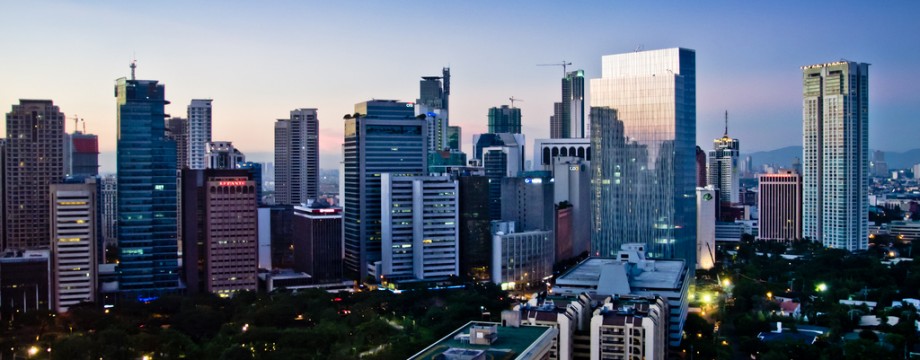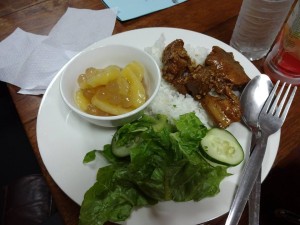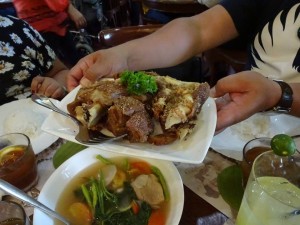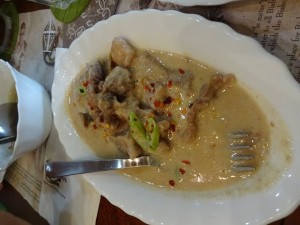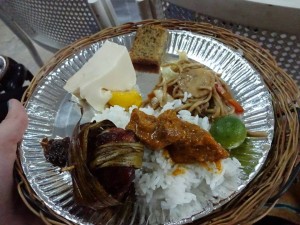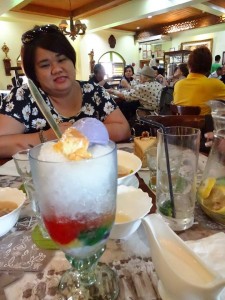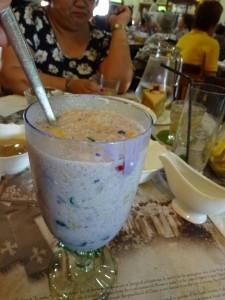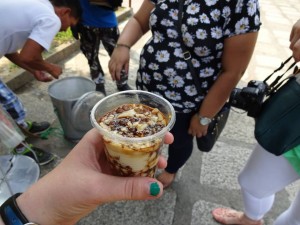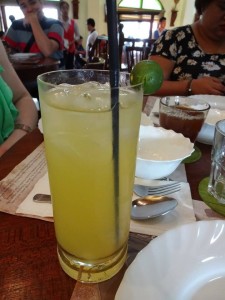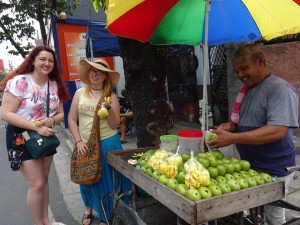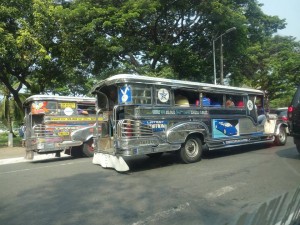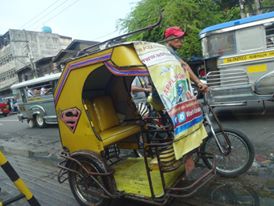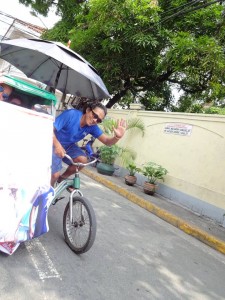Food here includes a lot of tropical fruits, vegetables, and seafood, although pork and chicken are also quite popular. And every dish is eaten with rice, even breakfast food. The way dishes are prepared varies hugely on the region the person making it comes from, as it’s done a little differently everywhere. There are also street vendors everywhere, although it’s generally not advisable to try any street food unless a local tells you it’s safe.

A street vendor prepares a variety of meats on skewers, including chicken intestine, liver, and congealed chicken blood, cubed and fried.
Here’s a sampling of what I’ve tried so far:
- Adobo, the “national dish” of the Philippines. Made with pork or chicken (or both) and cooked in vinegar, soy sauce, and garlic. No two adobo dishes are the same, as everywhere has its own take on it.
- Crispy pata – pork knuckles!
- Bicol Express. My favorite so far, it’s a stew made from green chilies, coconut milk, fish or shrimp paste, garlic, and sometimes includes meat.
- Kare-Kare, a meat, tripe, and oxtail stew cooked in a peanut sauce and served with bagoong – salted fish paste. Did not like this one very much.
- Sinigang. A sour soup made with meat or seafood, vegetables, and unripe fruits.
- Tocino, a sugar-cured pork, most often eaten for breakfast.
- Deep fried squid balls. Not really my thing either.
- Halo-Halo, a popular dessert served in a tall glass with shaved ice, various boiled beans, candies, and fruits, then milk is poured over it and you mix it up. The one I tried also came with flan and taro ice cream, and it was incredibly refreshing!
- Maja blanca, a sweet made of coconut milk and cornstarch. I believe the one I tried was made with taro as well, and had sweet corn kernels in it. The flavor was like cornbread, but it was purple and had the consistency of pudding, so this was really an experience.
- Taho, made from fresh soy tofu, sago pearls, and brown sugar/vanilla/caramel. It’s usually eaten served hot and for breakfast. I’m not very big on tofu, personally, and the hot slimy consistency of it put me off a little. It wouldn’t have been bad if I could get over the consistency.
- Calamansi! This is a small, round, cousin of the lime, but more sweet than sour. It makes very good juice and brings out the flavor in a lot of other dishes and fruits.
- This translates to mango, but the Philippine mango is a completely different experience than anything I’ve eaten elsewhere. The yellow Philippine mango (different from the Indian mango, which I’ll discuss below) fizzles in your mouth. They say Philippine mangoes, especially from the Visayas, are the best in the world, and I’d have to agree.
- Mango-ong. This is another mango dish, but made from Indian mangoes that are still green and unripe. Then you dip it in bagoong, a salted fish paste, or chili rock salt. A common street food.
- I have not yet tried balut, but that will be a hurdle indeed. It’s several day old fermented duck embryo – you crack open the egg and there’s the little fowl fetus with recognizable features. They say that agreeing to try balut is a quick way for foreigners to win the regard of Filipinos, as this is largely considered a delicacy, although most of the Filipinos I’ve gotten close to don’t care for it. But they’re delightedly looking forward to getting me to try it anyway…
Public transport is also very interesting. Aside from taxis and the LRT, which is basically like the EL, subway or Metro except cheaper (a ticket can cost P15-P40, so under a dollar) and infinitesimally more crowded (sometimes lines to buy a ticket can be off the platform and onto the stairs), there are the jeepneys, pedicabs, and motorcabs.
The jeepneys are reminders of American military occupation, as they’re converted from military jeeps. These, however, are flamboyantly painted affairs that are sometimes forced to accommodate 20+ people, even if it means having someone hanging off the sides or on the back. There are no timetables or set stops, so it requires a learning curve to flag them down and know where they’re going, although each one has a painted sign on the side with major street names that it will go to. Fares are very low though, and are on an honesty policy. Getting on will cost you P7.50 for 4km (just a few cents), with .50 more for every kilometer you stay on past that. When you’re stuck at the back, you just pass your fare up to the driver via other passengers, and yell “Para!” when you need to get off.
For both the crowded LRT and the jeepney, you really need to hold your purse or bag close to your body in front of you, as pickpockets and “snatchers” are fairly common (as in any other big city). Some even carry small knives so as to slit the back of a purse and grab something out of it if you carry it too far off to the side or on your back. We were also advised not to bring out our phones, cameras, or wallets on public transportation or in the street, so you should have a small coin purse for the small denominations of pesos or money prepared when you ride in a jeepney or are in line for the LRT.
Pedicabs are a bit more expensive, and consist of a cart attached to the side of a bicycle. Depending on the size of the cart, it can seat 2-4 people, and is powered exclusively by foot power. These are also the only things that will run during a flash flood, but they will obviously be more expensive in that case. Motorcabs are the mechanized version of this, with a motorbike instead of a regular bicycle.

